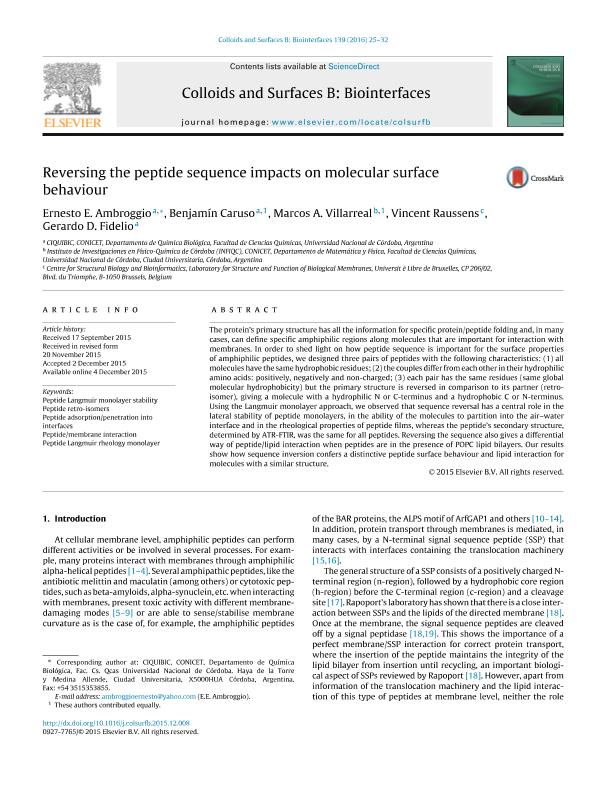Mostrar el registro sencillo del ítem
dc.contributor.author
Ambroggio, Ernesto Esteban

dc.contributor.author
Caruso, Benjamin

dc.contributor.author
Villarreal, Marcos Ariel

dc.contributor.author
Raussens, Vincent
dc.contributor.author
Fidelio, Gerardo Daniel

dc.date.available
2018-06-29T17:57:16Z
dc.date.issued
2016-03
dc.identifier.citation
Ambroggio, Ernesto Esteban; Caruso, Benjamin; Villarreal, Marcos Ariel; Raussens, Vincent; Fidelio, Gerardo Daniel; Reversing the peptide sequence impacts on molecular surface behaviour; Elsevier Science; Colloids and Surfaces B: Biointerfaces; 139; 3-2016; 25-32
dc.identifier.issn
0927-7765
dc.identifier.uri
http://hdl.handle.net/11336/50721
dc.description.abstract
The protein's primary structure has all the information for specific protein/peptide folding and, in many cases, can define specific amphiphilic regions along molecules that are important for interaction with membranes. In order to shed light on how peptide sequence is important for the surface properties of amphiphilic peptides, we designed three pairs of peptides with the following characteristics: (1) all molecules have the same hydrophobic residues; (2) the couples differ from each other in their hydrophilic amino acids: positively, negatively and non-charged; (3) each pair has the same residues (same global molecular hydrophobicity) but the primary structure is reversed in comparison to its partner (retro-isomer), giving a molecule with a hydrophilic N or C-terminus and a hydrophobic C or N-terminus. Using the Langmuir monolayer approach, we observed that sequence reversal has a central role in the lateral stability of peptide monolayers, in the ability of the molecules to partition into the air-water interface and in the rheological properties of peptide films, whereas the peptide's secondary structure, determined by ATR-FTIR, was the same for all peptides. Reversing the sequence also gives a differential way of peptide/lipid interaction when peptides are in the presence of POPC lipid bilayers. Our results show how sequence inversion confers a distinctive peptide surface behaviour and lipid interaction for molecules with a similar structure.
dc.format
application/pdf
dc.language.iso
eng
dc.publisher
Elsevier Science

dc.rights
info:eu-repo/semantics/openAccess
dc.rights.uri
https://creativecommons.org/licenses/by-nc-sa/2.5/ar/
dc.subject
Peptide Adsorption/Penetration Into Interfaces
dc.subject
Peptide Langmuir Monolayer Stability
dc.subject
Peptide Langmuir Rheology Monolayer
dc.subject
Peptide Retro-Isomers
dc.subject
Peptide/Membrane Interaction
dc.subject.classification
Otras Ciencias Biológicas

dc.subject.classification
Ciencias Biológicas

dc.subject.classification
CIENCIAS NATURALES Y EXACTAS

dc.title
Reversing the peptide sequence impacts on molecular surface behaviour
dc.type
info:eu-repo/semantics/article
dc.type
info:ar-repo/semantics/artículo
dc.type
info:eu-repo/semantics/publishedVersion
dc.date.updated
2018-06-29T16:44:06Z
dc.journal.volume
139
dc.journal.pagination
25-32
dc.journal.pais
Países Bajos

dc.journal.ciudad
Amsterdam
dc.description.fil
Fil: Ambroggio, Ernesto Esteban. Consejo Nacional de Investigaciones Científicas y Técnicas. Centro Científico Tecnológico Conicet - Córdoba. Centro de Investigaciones en Química Biológica de Córdoba. Universidad Nacional de Córdoba. Facultad de Ciencias Químicas. Centro de Investigaciones en Química Biológica de Córdoba; Argentina
dc.description.fil
Fil: Caruso, Benjamin. Consejo Nacional de Investigaciones Científicas y Técnicas. Centro Científico Tecnológico Conicet - Córdoba. Centro de Investigaciones en Química Biológica de Córdoba. Universidad Nacional de Córdoba. Facultad de Ciencias Químicas. Centro de Investigaciones en Química Biológica de Córdoba; Argentina
dc.description.fil
Fil: Villarreal, Marcos Ariel. Consejo Nacional de Investigaciones Científicas y Técnicas. Centro Científico Tecnológico Conicet - Córdoba. Instituto de Investigaciones en Físico-química de Córdoba. Universidad Nacional de Córdoba. Facultad de Ciencias Químicas. Instituto de Investigaciones en Físico-química de Córdoba; Argentina
dc.description.fil
Fil: Raussens, Vincent. Université Libre de Bruxelles; Bélgica
dc.description.fil
Fil: Fidelio, Gerardo Daniel. Consejo Nacional de Investigaciones Científicas y Técnicas. Centro Científico Tecnológico Conicet - Córdoba. Centro de Investigaciones en Química Biológica de Córdoba. Universidad Nacional de Córdoba. Facultad de Ciencias Químicas. Centro de Investigaciones en Química Biológica de Córdoba; Argentina
dc.journal.title
Colloids and Surfaces B: Biointerfaces

dc.relation.alternativeid
info:eu-repo/semantics/altIdentifier/url/http://www.sciencedirect.com/science/article/pii/S0927776515303568
dc.relation.alternativeid
info:eu-repo/semantics/altIdentifier/doi/http://dx.doi.org/10.1016/j.colsurfb.2015.12.008
Archivos asociados
